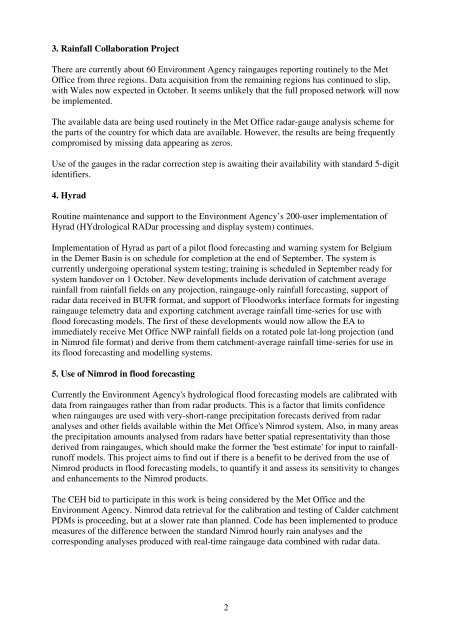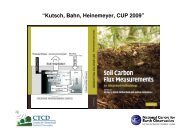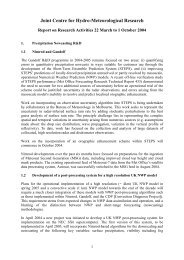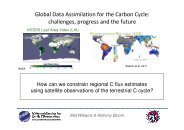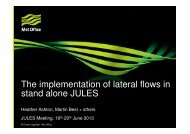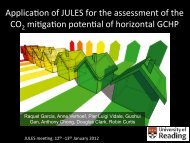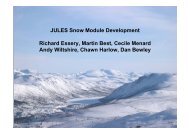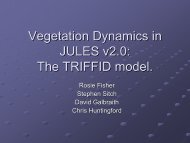here in PDF format - Joint Centre for Hydro-Meteorological Research
here in PDF format - Joint Centre for Hydro-Meteorological Research
here in PDF format - Joint Centre for Hydro-Meteorological Research
Create successful ePaper yourself
Turn your PDF publications into a flip-book with our unique Google optimized e-Paper software.
3. Ra<strong>in</strong>fall Collaboration Project<br />
T<strong>here</strong> are currently about 60 Environment Agency ra<strong>in</strong>gauges report<strong>in</strong>g rout<strong>in</strong>ely to the Met<br />
Office from three regions. Data acquisition from the rema<strong>in</strong><strong>in</strong>g regions has cont<strong>in</strong>ued to slip,<br />
with Wales now expected <strong>in</strong> October. It seems unlikely that the full proposed network will now<br />
be implemented.<br />
The available data are be<strong>in</strong>g used rout<strong>in</strong>ely <strong>in</strong> the Met Office radar-gauge analysis scheme <strong>for</strong><br />
the parts of the country <strong>for</strong> which data are available. However, the results are be<strong>in</strong>g frequently<br />
compromised by miss<strong>in</strong>g data appear<strong>in</strong>g as zeros.<br />
Use of the gauges <strong>in</strong> the radar correction step is await<strong>in</strong>g their availability with standard 5-digit<br />
identifiers.<br />
4. Hyrad<br />
Rout<strong>in</strong>e ma<strong>in</strong>tenance and support to the Environment Agency’s 200-user implementation of<br />
Hyrad (HYdrological RADar process<strong>in</strong>g and display system) cont<strong>in</strong>ues.<br />
Implementation of Hyrad as part of a pilot flood <strong>for</strong>ecast<strong>in</strong>g and warn<strong>in</strong>g system <strong>for</strong> Belgium<br />
<strong>in</strong> the Demer Bas<strong>in</strong> is on schedule <strong>for</strong> completion at the end of September. The system is<br />
currently undergo<strong>in</strong>g operational system test<strong>in</strong>g; tra<strong>in</strong><strong>in</strong>g is scheduled <strong>in</strong> September ready <strong>for</strong><br />
system handover on 1 October. New developments <strong>in</strong>clude derivation of catchment average<br />
ra<strong>in</strong>fall from ra<strong>in</strong>fall fields on any projection, ra<strong>in</strong>gauge-only ra<strong>in</strong>fall <strong>for</strong>ecast<strong>in</strong>g, support of<br />
radar data received <strong>in</strong> BUFR <strong><strong>for</strong>mat</strong>, and support of Floodworks <strong>in</strong>terface <strong><strong>for</strong>mat</strong>s <strong>for</strong> <strong>in</strong>gest<strong>in</strong>g<br />
ra<strong>in</strong>gauge telemetry data and export<strong>in</strong>g catchment average ra<strong>in</strong>fall time-series <strong>for</strong> use with<br />
flood <strong>for</strong>ecast<strong>in</strong>g models. The first of these developments would now allow the EA to<br />
immediately receive Met Office NWP ra<strong>in</strong>fall fields on a rotated pole lat-long projection (and<br />
<strong>in</strong> Nimrod file <strong><strong>for</strong>mat</strong>) and derive from them catchment-average ra<strong>in</strong>fall time-series <strong>for</strong> use <strong>in</strong><br />
its flood <strong>for</strong>ecast<strong>in</strong>g and modell<strong>in</strong>g systems.<br />
5. Use of Nimrod <strong>in</strong> flood <strong>for</strong>ecast<strong>in</strong>g<br />
Currently the Environment Agency's hydrological flood <strong>for</strong>ecast<strong>in</strong>g models are calibrated with<br />
data from ra<strong>in</strong>gauges rather than from radar products. This is a factor that limits confidence<br />
when ra<strong>in</strong>gauges are used with very-short-range precipitation <strong>for</strong>ecasts derived from radar<br />
analyses and other fields available with<strong>in</strong> the Met Office's Nimrod system. Also, <strong>in</strong> many areas<br />
the precipitation amounts analysed from radars have better spatial representativity than those<br />
derived from ra<strong>in</strong>gauges, which should make the <strong>for</strong>mer the 'best estimate' <strong>for</strong> <strong>in</strong>put to ra<strong>in</strong>fallrunoff<br />
models. This project aims to f<strong>in</strong>d out if t<strong>here</strong> is a benefit to be derived from the use of<br />
Nimrod products <strong>in</strong> flood <strong>for</strong>ecast<strong>in</strong>g models, to quantify it and assess its sensitivity to changes<br />
and enhancements to the Nimrod products.<br />
The CEH bid to participate <strong>in</strong> this work is be<strong>in</strong>g considered by the Met Office and the<br />
Environment Agency. Nimrod data retrieval <strong>for</strong> the calibration and test<strong>in</strong>g of Calder catchment<br />
PDMs is proceed<strong>in</strong>g, but at a slower rate than planned. Code has been implemented to produce<br />
measures of the difference between the standard Nimrod hourly ra<strong>in</strong> analyses and the<br />
correspond<strong>in</strong>g analyses produced with real-time ra<strong>in</strong>gauge data comb<strong>in</strong>ed with radar data.<br />
2


